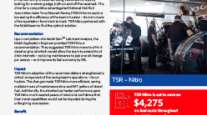Diesel Prices Slip Again to $3.849 While Gasoline Inches Upward
This story appears in the June 17 print edition of Transport Topics.
U.S. retail diesel prices continued their downward slide, dipping 2 cents more a gallon last week, the third straight decline, pushing the national average down to $3.849, the Department of Energy reported.
The recent declines add up to 4.1 cents a gallon but still left the retail diesel average 6.8 cents higher than a year ago. Price declines for diesel occurred in every region of the country, DOE’s Energy Information Administration said after its June 10 survey of fueling stations.
Gasoline, however, inched up 0.9 cent to $3.655 a gallon, the agency said. The gas average has increased in five of the past six weeks, including 1 cent a gallon over the past two. A year ago, gasoline was 8.3 cents a gallon cheaper.
Fleet executives cheered the diesel decline, although they expressed doubt they would continue.
“Fuel is one of our top two expenses [along with labor], so we love it when we can catch a break,” said Carol Barrett, fuel specialist for Keen Transport in Carlisle, Pa. “As a heavy-haul and oversize carrier, our deadhead miles are 33%, and the fuel surcharge doesn’t cover that.”
The company used about 485,000 gallons of diesel in May for its 275 tractors and 75 additional power units at subsidiary Cressler Trucking.
Barrett said Keen and Cressler negotiate discounts with truck stop chains, govern maximum truck speed at 65 miles per hour, coach drivers to operate in higher gears and with minimal idling, and specify locations for fuel purchases.
The price stability for diesel coincides with a high supply level for crude oil. The U.S. crude oil inventory rose by 2.5 million barrels in one week to 393.8 million on June 7, EIA said in the middle of last week. A year ago the inventory level was 384.4 million barrels.
“We are not running out of oil,” Tim Evans, an energy analyst at Citi Futures Perspective told Bloomberg News after the EIA inventory report. “This is a clearly a bearish data set overall” for petroleum prices, he said.
Butch Brown, president of less-than-truckload carrier Brown Transfer Co., Kearney, Neb., said he sees a mismatch between crude and diesel prices, and wonders why New York Mercantile Exchange crude has not pushed diesel up higher but that he enjoys the status quo.
“I’m pleasantly surprised on fuel. I thought it would be bouncing up around $4 to $4.25 a gallon because of crude, but it’s come down,” Brown said. “I can’t put a finger on it, but I’m happy.”
His larger customers check the national diesel average directly and note changes in whatever direction they move.
“This is good for customers,” Brown said, adding that lower fuel prices probably help keep his trucks busy.
Brown said the company started by his grandfather has been investing in new tractors for linehaul routes and moving the older vehicles to pickup-and-delivery work within a 150-mile radius of the home terminal.
“We’re getting six more with the new engines this month. There’s improved fuel economy,” Brown said. His 110 power units burn more than 20,000 gallons of fuel a week, he said.
Nymex crude oil futures contracts closed at $96.69 a barrel on June 13. Since April 25, prices have oscillated between $91 and $97 but have not moved clearly up or down. The 12-month high for Nymex crude is $99 a barrel on Sept. 14.
The Energy Information Administration updated its Short-Term Energy Outlook pricing forecast on June 11, saying that crude and diesel prices through the end of 2014 probably will be somewhat lower than the agency had predicted in early May.
Nationwide, retail diesel will average $3.79 a gallon during the third quarter and $3.82 in the fourth quarter, EIA estimated. On May 7, the agency had predicted $3.87 and $3.88, respectively.
The 2014 projection was trimmed to $3.77 a gallon for the year, on average, from $3.79.
EIA also pared its 2014 price forecast for domestic West Texas Intermediate crude and Brent crude in the United Kingdom. For the U.S. product, the price is now expected to average $91.96 a barrel, down from $92.25, while the European commodity projection dipped to $99.75 from $100.75.
Domestically produced crude dipped below imports during the week ended June 7. Production was 7.22 million barrels a day, and imports were 7.85 million. For the week ended May 31, domestic production topped crude for the first time since 1997.
Refineries produced at 87.5% of capacity through June 7, down from 88.4% through May 31.




